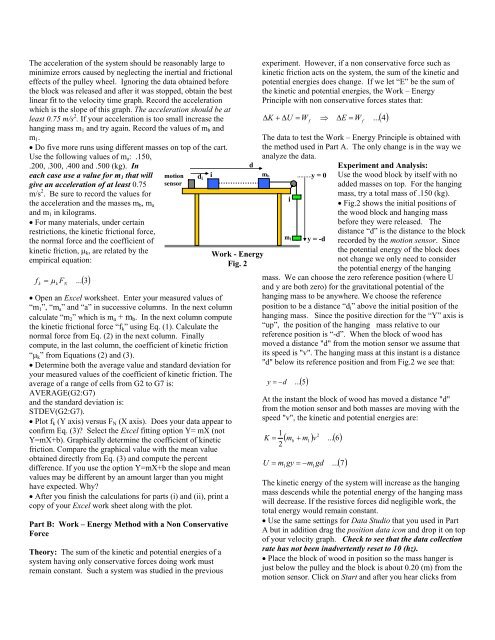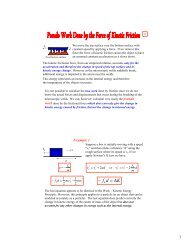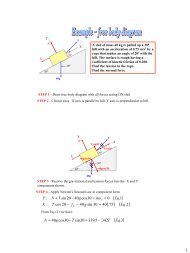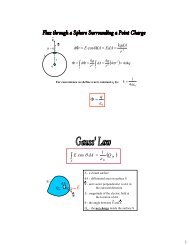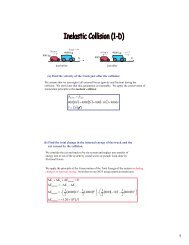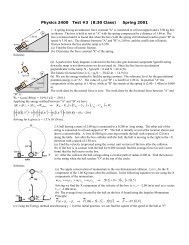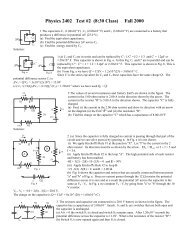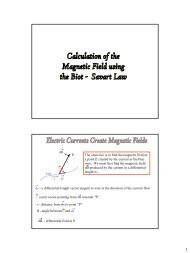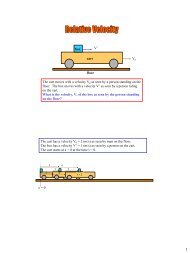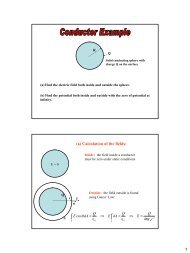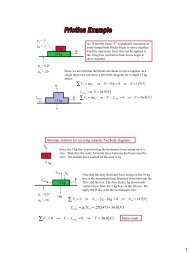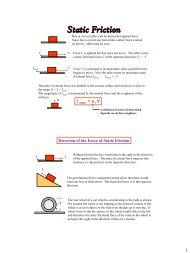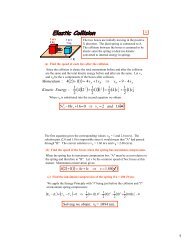Friction Laws and Work-Energy with Non Conservative Forces
Friction Laws and Work-Energy with Non Conservative Forces
Friction Laws and Work-Energy with Non Conservative Forces
You also want an ePaper? Increase the reach of your titles
YUMPU automatically turns print PDFs into web optimized ePapers that Google loves.
The acceleration of the system should be reasonably large tominimize errors caused by neglecting the inertial <strong>and</strong> frictionaleffects of the pulley wheel. Ignoring the data obtained beforethe block was released <strong>and</strong> after it was stopped, obtain the bestlinear fit to the velocity time graph. Record the accelerationwhich is the slope of this graph. The acceleration should be atleast 0.75 m/s 2 . If your acceleration is too small increase thehanging mass m 1 <strong>and</strong> try again. Record the values of m b <strong>and</strong>m 1 .• Do five more runs using different masses on top of the cart.Use the following values of m a : .150,.200, .300, .400 <strong>and</strong> .500 (kg). Ineach case use a value for m 1 that willgive an acceleration of at least 0.75m/s 2 . Be sure to record the values forthe acceleration <strong>and</strong> the masses m b , m a<strong>and</strong> m 1 in kilograms.• For many materials, under certainrestrictions, the kinetic frictional force,the normal force <strong>and</strong> the coefficient ofkinetic friction, μ k , are related by theempirical equation:fk= μ FkN...()3motionsensor• Open an Excel worksheet. Enter your measured values of“m 1 ”, “m a ” <strong>and</strong> “a” in successive columns. In the next columncalculate “m 2 ” which is m a + m b . In the next column computethe kinetic frictional force “f k ” using Eq. (1). Calculate thenormal force from Eq. (2) in the next column. Finallycompute, in the last column, the coefficient of kinetic friction“μ k ” from Equations (2) <strong>and</strong> (3).• Determine both the average value <strong>and</strong> st<strong>and</strong>ard deviation foryour measured values of the coefficient of kinetic friction. Theaverage of a range of cells from G2 to G7 is:AVERAGE(G2:G7)<strong>and</strong> the st<strong>and</strong>ard deviation is:STDEV(G2:G7).• Plot f k (Y axis) versus F N (X axis). Does your data appear toconfirm Eq. (3)? Select the Excel fitting option Y= mX (notY=mX+b). Graphically determine the coefficient of kineticfriction. Compare the graphical value <strong>with</strong> the mean valueobtained directly from Eq. (3) <strong>and</strong> compute the percentdifference. If you use the option Y=mX+b the slope <strong>and</strong> meanvalues may be different by an amount larger than you mighthave expected. Why?• After you finish the calculations for parts (i) <strong>and</strong> (ii), print acopy of your Excel work sheet along <strong>with</strong> the plot.Part B: <strong>Work</strong> – <strong>Energy</strong> Method <strong>with</strong> a <strong>Non</strong> <strong>Conservative</strong>ForceTheory: The sum of the kinetic <strong>and</strong> potential energies of asystem having only conservative forces doing work mustremain constant. Such a system was studied in the previousd idi m bim 1<strong>Work</strong> - <strong>Energy</strong>Fig. 2experiment. However, if a non conservative force such askinetic friction acts on the system, the sum of the kinetic <strong>and</strong>potential energies does change. If we let “E” be the sum ofthe kinetic <strong>and</strong> potential energies, the <strong>Work</strong> – <strong>Energy</strong>Principle <strong>with</strong> non conservative forces states that:ΔK + ΔU= W ⇒ ΔE=fW f...( 4)The data to test the <strong>Work</strong> – <strong>Energy</strong> Principle is obtained <strong>with</strong>the method used in Part A. The only change is in the way weanalyze the data.Experiment <strong>and</strong> Analysis:Use the wood block by itself <strong>with</strong> noadded masses on top. For the hangingmass, try a total mass of .150 (kg).• Fig.2 shows the initial positions ofthe wood block <strong>and</strong> hanging massbefore they were released. Thedistance “d” is the distance to the blockrecorded by the motion sensor. Sincethe potential energy of the block doesnot change we only need to considerthe potential energy of the hangingmass. We can choose the zero reference position (where U<strong>and</strong> y are both zero) for the gravitational potential of thehanging mass to be anywhere. We choose the referenceposition to be a distance “d i ” above the initial position of thehanging mass. Since the positive direction for the “Y” axis is“up”, the position of the hanging mass relative to ourreference position is “-d”. When the block of wood hasmoved a distance "d" from the motion sensor we assume thatits speed is "v". The hanging mass at this instant is a distance"d" below its reference position <strong>and</strong> from Fig.2 we see that:y = −d...( 5)At the instant the block of wood has moved a distance "d"from the motion sensor <strong>and</strong> both masses are moving <strong>with</strong> thespeed "v", the kinetic <strong>and</strong> potential energies are:1 2= ( ) ...( 6)2m m v 1= m gy = −m...( 7)K b +Uy = 0y = -d1 1gdThe kinetic energy of the system will increase as the hangingmass descends while the potential energy of the hanging masswill decrease. If the resistive forces did negligible work, thetotal energy would remain constant.• Use the same settings for Data Studio that you used in PartA but in addition drag the position data icon <strong>and</strong> drop it on topof your velocity graph. Check to see that the data collectionrate has not been inadvertently reset to 10 (hz).• Place the block of wood in position so the mass hanger isjust below the pulley <strong>and</strong> the block is about 0.20 (m) from themotion sensor. Click on Start <strong>and</strong> after you hear clicks from


